9870 St Vincent Place, Glasgow, DC 45 Fr 45.
Вид: Tapirus pinchaque Roulin, 1829 = Горный тапир
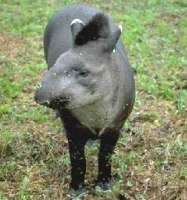
- Класс: Mammalia Linnaeus, 1758 = Млекопитающие
- Подкласс: Theria Parker et Haswell, 1879 = Живородящие млекопитающие, настоящие звери
- Инфракласс: Eutheria, Placentalia Gill, 1872 = Плацентарные, высшие звери
- Надотряд: Ungulata = Копытные
- Отряд: Perissodactyla Owen, 1848 = Непарнокопытные, непарнопалые
- Семейство: Tapiridae Burnett, 1830 = Тапировые
- Род: Tapirus Brunnich, 1772 = Тапиры
- Вид: Tapirus pinchaque Roulin, 1829 = Горный тапир
Вид: Tapirus pinchaque Roulin, 1829 = Горный тапир
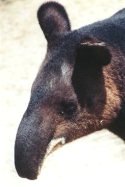
ТАПИР ГОРНЫЙ (Tapirus pinchaque) самый маленький и изящный из тапиров: длина его тела около 180 см, высота в холке 75—80 см, масса — 225—250 кг. Шерсть, в отличие от других тапиров, сравнительно мягкая, волнистая и густая. Ра спространен он в Андах (Колумбия, Эквадор, Перу и Венесуэла) на высоте 2000—4000 м над уровнем моря; обитает в лесах, но встречается и у самой снеговой линии высокогорья. Образ жизни неизвестен. Включен в международную Красную книгу как очень редкий вид (http://www.floranimal.ru/pages/animal/t/174.html)
General Characteristics
Body Length: 180 cm / 6 ft. Shoulder Height: 75-80 cm / 30-32 in. Tail Length: 5-10 cm / 2-4 in. Weight: 225-250 kg / 495-550 lb
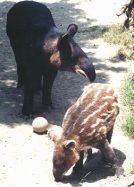
The coat is thick, rough, and long-haired, with an insulating layer of underfur. Covering the thinnest skin among tapirs, the wooly hair ranges in colour from coal black to dark reddish-brown. The cheeks may be lighter. As with all species of tapir, young animals look more like reddish-brown watermelons. The white stripes and spots gradually fade from the darkening wooly brown coat, reaching adult coloration around one year of age. The lips are startlingly white, and the edges of the ears are often the same. Typical of tapirs, the nose is long and prehensile, and the eyes are small and beady. The body is round and barrel-shaped, and the short tail is stump-like.
Ontogeny and Reproduction
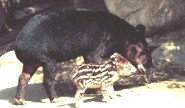
Gestation Period: 390-400 days. Yo ung per Birth: 1, rarely 2. Weaning: By 1 year. Sexual Maturity: At about 3 years. Life span: Up to 30 years.
Ecology and Behavior
Primarily active from late afternoon until early morning, the mountain tapir rests in thick vegetation during the day. They are surprising agile and sure-footed, and can move easily through dense plant growth. Worn paths, made by the tapirs, are the primary routes for travelling. Climbing slopes presents no problem, and, like all tapirs, are fond of bathing and wallow. Normally shy, mountain tapirs generally flee, either to water or into dense vegetation, when confronted with danger. However, if cornered they can make formidable opponents, fighting viciously. This behavior is also seen when males engage in fights over estrous females, using their well-developed teeth in an attempt to lacerate their opponent's rear legs. The main form of 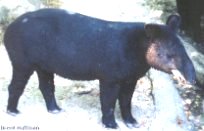 communication is a shrill whistle, which sounds more likely to be made by a bird than a large mammal.
communication is a shrill whistle, which sounds more likely to be made by a bird than a large mammal.
Family group: Solitary.
Diet: Shoots and plant stems.
Main Predators: Mountain lions, jaguar, humans.
Distribution
Mountainous terrain at elevations 2,000-4,500 m / 6,400-14,400 ft. in the equatorial Andes (Colombia, Ecuador, and Peru).
Conservation Status
The mountain tapir is considered to be an endangered species by the IUCN (1996). http://www.ultimateungulate.com/Perissodactyla/Tapirus_indicus.html
